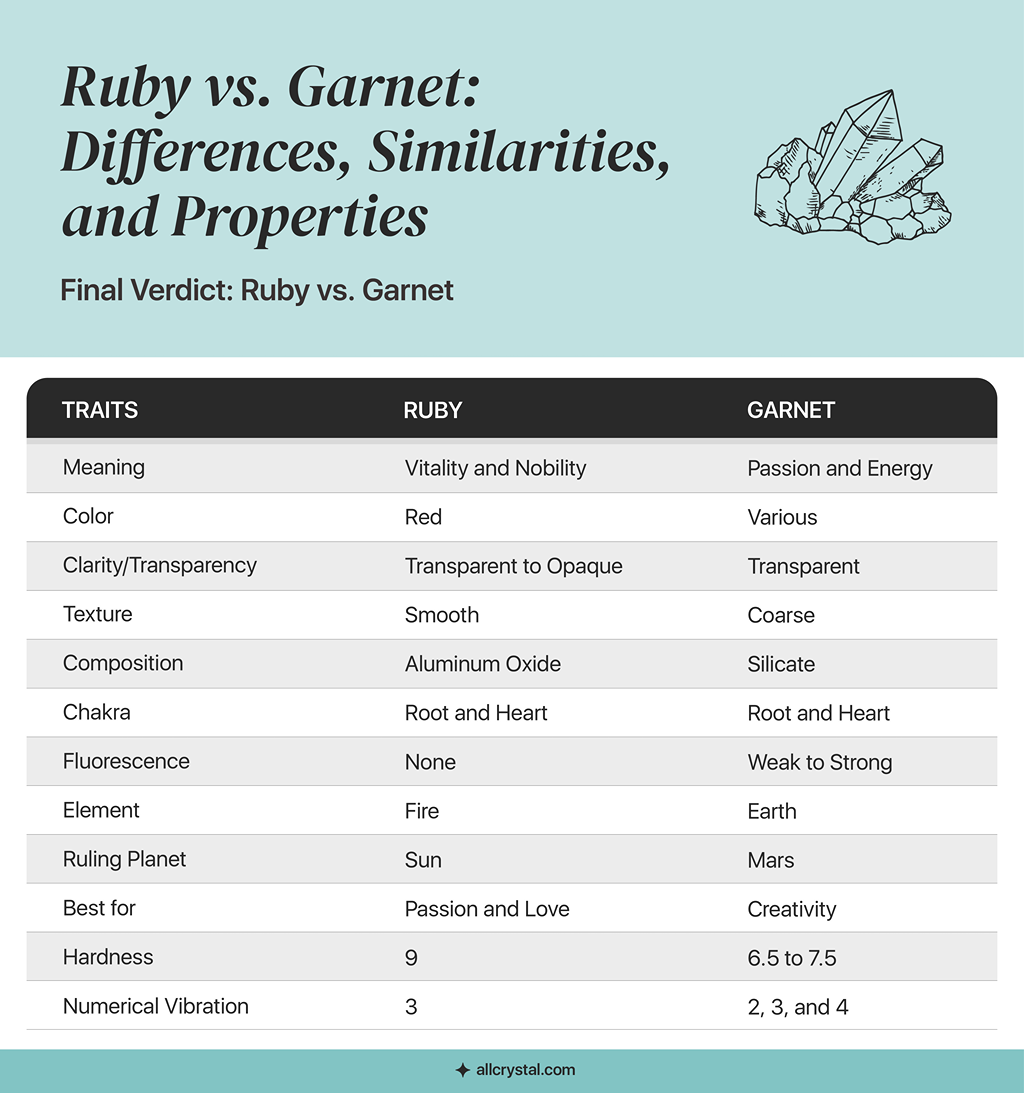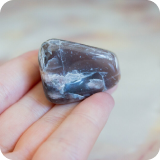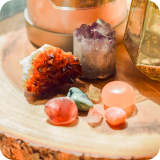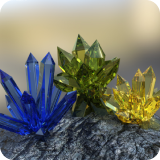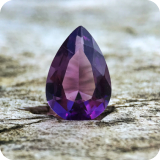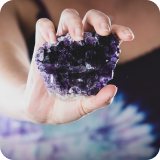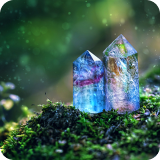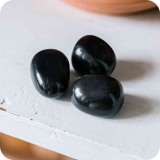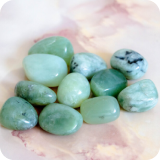- What Is a Ruby Crystal?
- What Is A Garnet Crystal?
- 9 Similarities Between Ruby and Garnet
- 14 Differences between Ruby and Garnet
- How To Identify Ruby from Garnet?
- Final Verdict: Ruby vs. Garnet
Both Ruby and Garnet are stunning gemstones that have captured the hearts of many. These two precious stones share some similarities that may surprise you.
Are Ruby and Garnet the same? How is Ruby different from Garnet? Do they have any similarities? Let’s find out!
Ruby and Garnet, both unique and precious gemstones, differ significantly in their composition, color, and hardness. Ruby is a fiery red gemstone and belongs to the corundum family, while Garnet is a group of minerals that come in different colors, including red. Both Ruby and Garnet are believed to have similar metaphysical properties, such as promoting love, passion, and inner strength.
Do you want to discover the distinguishing features and striking similarities between Ruby and Garnet? Discover the fascinating properties of Ruby and Garnet in this article, including their history, folklore, and how to use them. If you have a fascination for crystals or are keen on exploring the magical realm of astrology, get ready to be delighted! This article is for you.
What Is a Ruby Crystal?
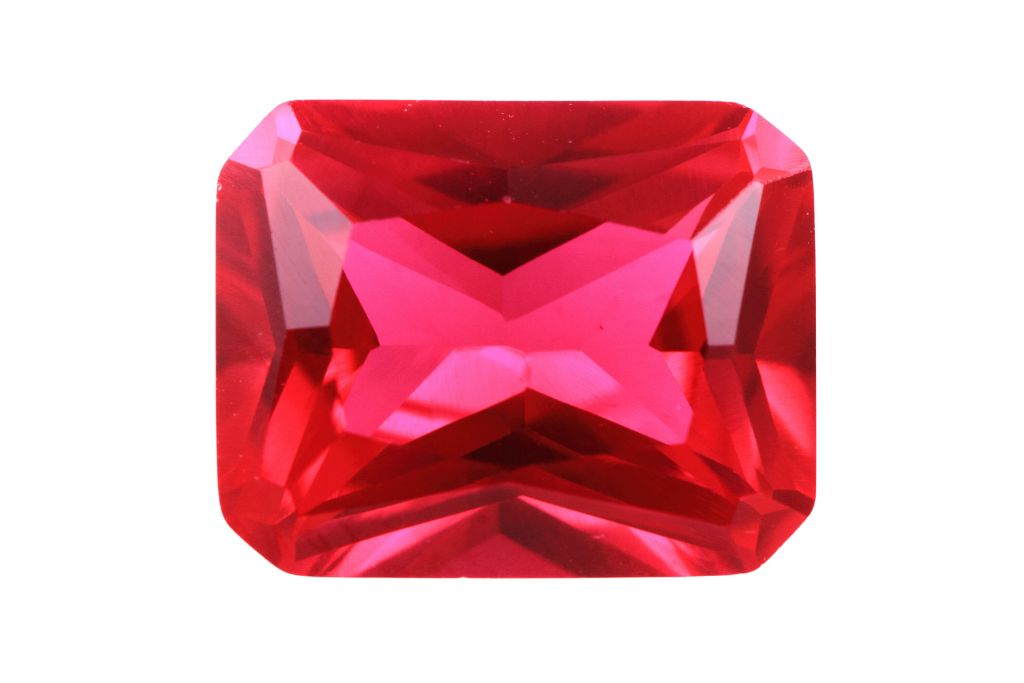
Ruby is widely revered as the “King of Gems” and highly coveted worldwide, primarily because of its vivid red hue that radiates sheer elegance and glamor. This crystal exhibits a stunning range of hues from a delicate blush to a bold and vivid red, and its dazzling radiance sets them apart from any other gemstone.
Its name comes from the Latin word “ruber,” which means “red” and is composed mainly of aluminum oxide. The red color comes from the presence of chromium and iron within the crystal, and the crystal structure gives them a unique six-sided shape.
These crystals are formed deep within the Earth’s mantle under extreme heat and pressure. The process takes millions of years and involves the crystallization of minerals in magma chambers.
Rubies frequently occur in alluvial deposits, where they are exposed to natural erosion and weathering processes.
From ancient folklore to modern science, Rubies have fascinated people for centuries. Rubies have been studied for their exclusive characteristics, such as their capability to take in light and radiate a vibrant red shine. Some people believe that Rubies can bring good luck, prosperity, and love into their lives.
Rubies have been cherished for centuries and are commonly linked with emotions, such as love, passion, and bravery.
Back in ancient times, people believed in the mystical and protective powers of Ruby crystals. Warriors would wear these gemstones as an amulet for protection during battles. Today, Rubies continue to be highly valued and are often used in engagement rings and other fine jewelry.
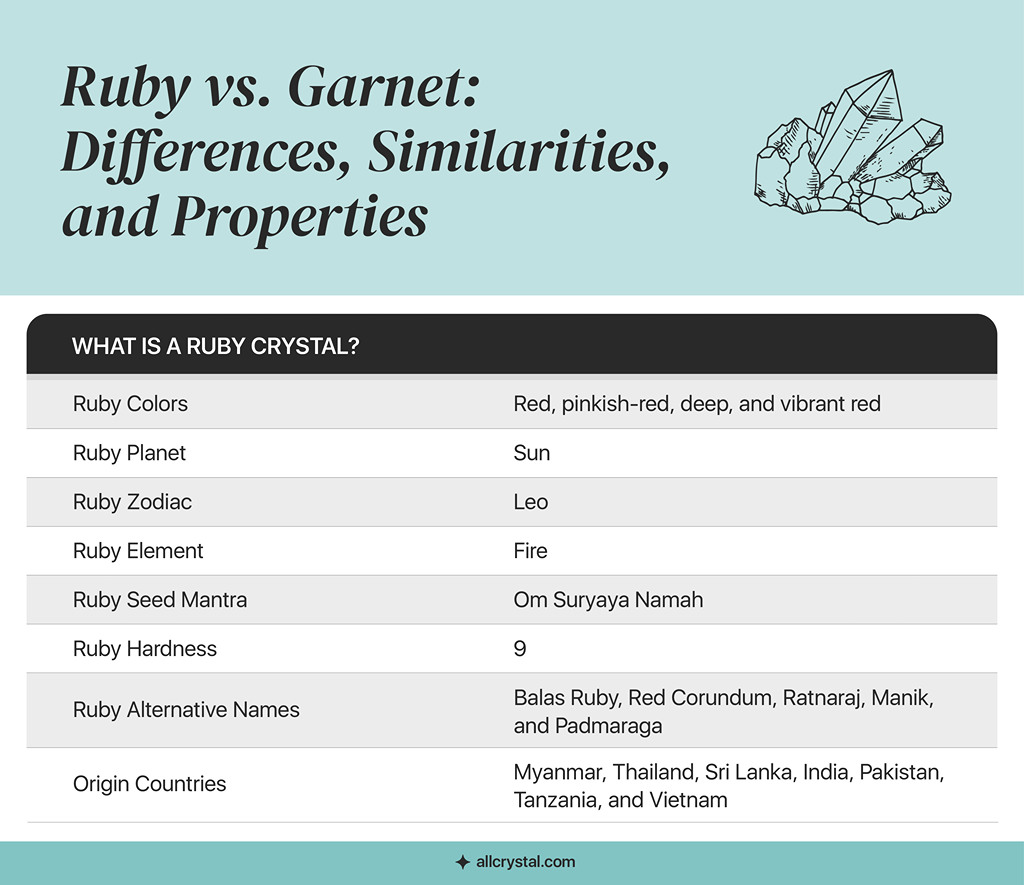
What Is A Garnet Crystal?
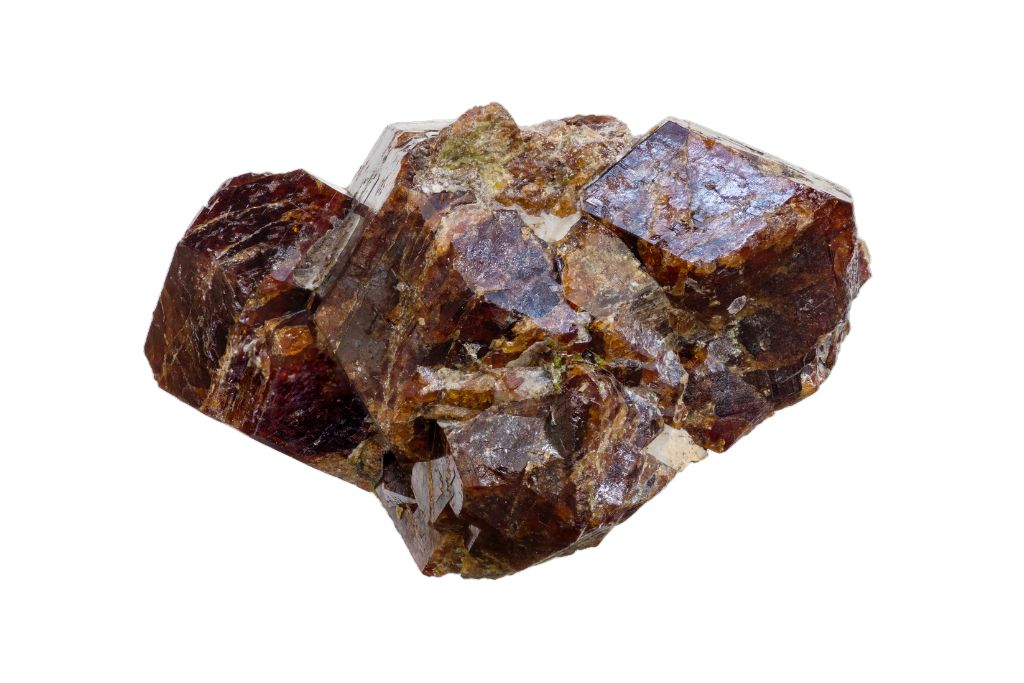
Garnet is marked as a “Stone of Health,” as it is said to possess healing properties that can benefit one’s well-being. Garnet in Latin term is “granatum,” which translates to “pomegranate,” inspired by its resemblance to the fruit’s vivid red seeds.
This crystal comes from a group of silicate minerals that share similar crystal structures but come in different colors, each with its unique meaning. Its shades include red, pink, green, purple, and brown, while some have a unique color-change property, displaying different colors under different lighting conditions.
These crystals have a beautiful, lustrous appearance that varies depending on the type of Garnet. Most Garnets are translucent to transparent and have a glass-like luster, but some may appear dull or matte.
Garnets are often found in regions with high geological activity, such as mountain ranges and volcanic areas. These stunning crystals are born deep beneath the Earth’s surface through an array of geological occurrences, like crystallization from molten rock or transformation of already existing rocks.
Throughout history, Garnets have been revered for their perceived healing properties and role in promoting emotional balance and stability. In ancient times, they were thought to protect against negativity and evil spirits. Today, Garnets are still valued for their beauty and ability to bring positive energy and good fortune to those who wear them.
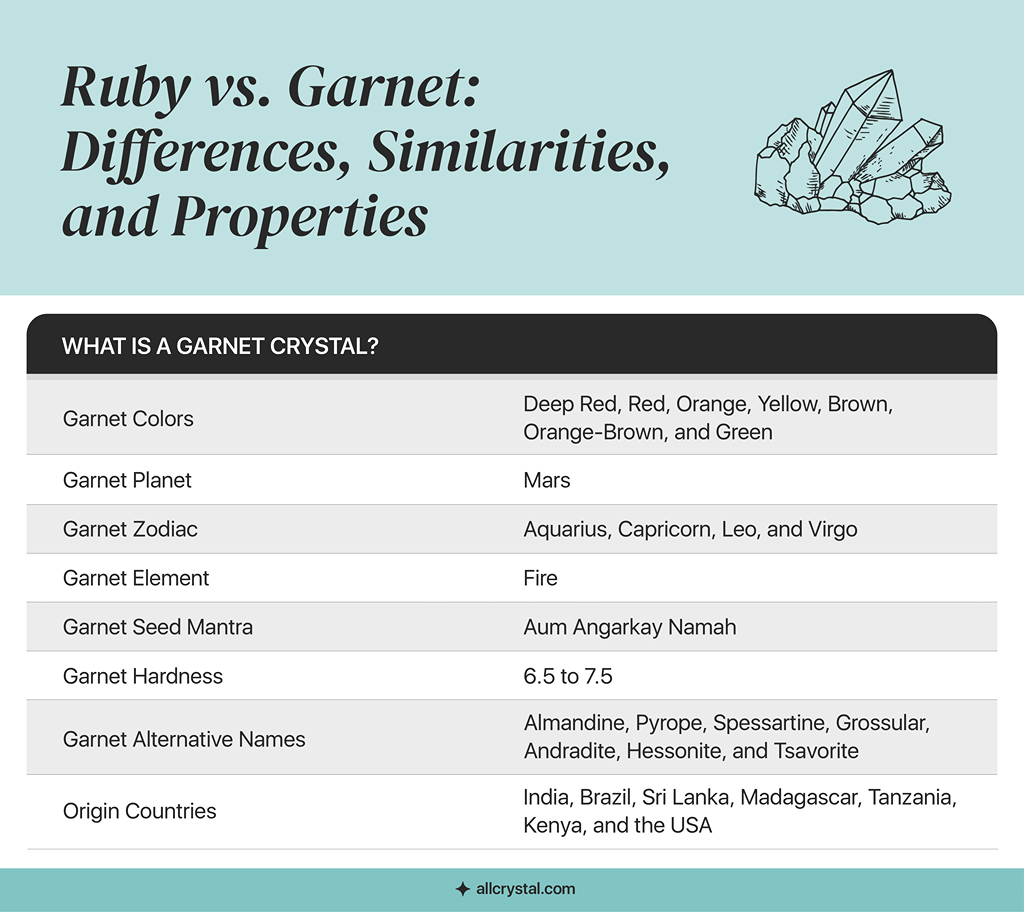
9 Similarities Between Ruby and Garnet
When it comes to precious gemstones, Rubies, and Garnets are often compared due to their similarities in appearance and properties. From their rich red hues to their durability and symbolism, these two stones share many characteristics that make them highly prized and sought after.
Same Color
Ruby and Garnet come in various colors, but their most typical shade is red. In fact, the deep red hue of some Garnets is so similar to Rubies that they were once mistaken for the same gemstone. This shared color is due to their similar chemical composition, with both stones being made primarily of aluminum and oxygen.
Same Durability
Another similarity between Ruby and Garnet is their durability. Both stones are relatively hard and highly resistant to abrasion. This makes them ideal for use in jewelry that will see frequent wear, as they are less likely to scratch or chip than other, less durable stones. They are also used in other applications that require tough, long-lasting materials.
Same Metaphysical Powers
In the world of crystal healing, both Ruby and Garnet have powerful metaphysical properties. Both stones are associated with vitality and courage and are thought to bring strength and energy to those who wear or carry them.
These crystals also help in balancing energy and increasing motivation and self-confidence. Both are to be beneficial for enhancing creativity and passion.
Same Mineral Associations
Ruby and Garnet are both associated with other minerals, particularly feldspar. This is because they are both formed in the same types of metamorphic and igneous rocks that often contain feldspar as a significant component.
Same Locations
Ruby and Garnet can be found in various locations worldwide, such as the United States, Madagascar, Sri Lanka, and Tanzania. Ruby and Garnet tend to occur in regions with significant geological activity, such as volcanic regions and mountainous areas.
Same Transparency
Both Ruby and Garnet are transparent gemstones, meaning that they allow light to pass through them. This transparency is part of what gives them their striking visual appeal and allows their deep red colors to shine.
Both are found in Metamorphic Rocks
Ruby and Garnet are formed in metamorphic rocks, created through intense heat and pressure deep within the Earth’s crust. These rocks are often found in mountainous regions from pre-existing rocks with altered geological processes.
Same Shiny Luster
Both Ruby and Garnet have a bright, shiny luster that adds to their visual appeal. This luster results from how the crystal structures of the stones interact with light, creating a sparkling effect that catches the eye.
Both Open the Same Chakra
In crystal healing, both Ruby and Garnet open the Heart Chakra. The Heart Chakra, situated at the center of the chest, is linked with emotions like love, compassion, and emotional healing. Some practitioners also believe that Ruby and Garnet can stimulate the Root Chakra, associated with grounding and stability.
14 Differences between Ruby and Garnet
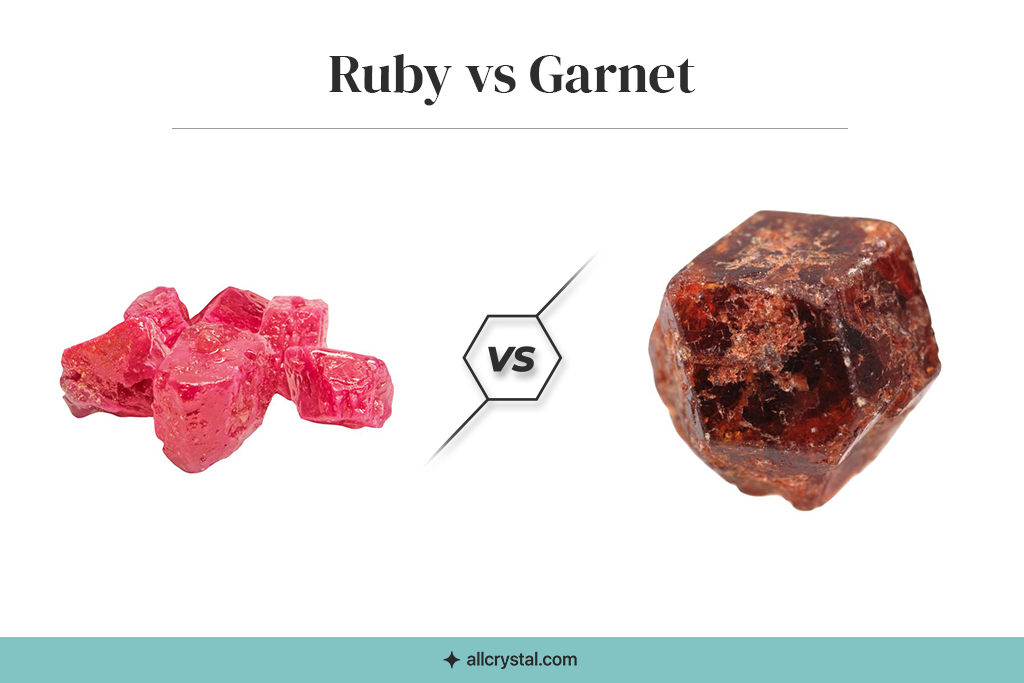
Ruby and Garnet are highly desirable and coveted gemstones in the world of jewelry. While both are prized for their beauty, several differences between Garnet and Ruby are essential to note. Understanding these distinctions can assist you in selecting the ideal gemstone for your specific requirements.
Different Mineral Family
Ruby is classified as a corundum mineral, while Garnet falls under the silicate mineral group. This means that they have different physical and chemical properties. Ruby has a higher hardness on the Mohs scale than Garnet, making it more durable and resistant to scratches.
Difference in Color Zoning
Ruby has a more uniform color distribution than Garnet. Garnet often displays color zoning, where different parts of the gemstone have varying colors. This can make the stone look uneven in color and less valuable.
Difference in Inclusion
Garnet usually has more inclusions than Ruby. These inclusions are tiny imperfections within the gemstone that can affect its clarity and overall value. Ruby has fewer inclusions and is often more transparent.
- Observe color: Hold the stone up to natural light and compare the colors of the stones side by side.
- Check the Refractive Index: Shine a light through the crystal and look for a bright red color with a fiery glow.
- Assess the Inclusions: Use a jeweler’s loupe to examine the stone for visible inclusions.
- Evaluate the Hardness: Test the stone’s hardness by scratching it against a hard surface.
- Consider the Origin: Ask the seller for information about the stone’s origin or look for information on the stone’s certificate of authenticity.
Difference in Color
Ruby displays a broader range of colors than Garnet. Ruby can be found in shades of red, pink, purple, orange, and brown. In contrast, Garnet is mainly known for its deep red color. Although Garnet can come in other colors, such as green and yellow, it is not as versatile as Ruby.
Difference in Mineral Composition
Both crystals have different mineral compositions. Ruby is made of aluminum oxide with traces of chromium, while Garnet combines other silicate minerals with varying amounts of metal ions. These differences in mineral composition can affect the physical and chemical properties of the gemstones.
Difference in Fluorescence
Ruby exhibits strong fluorescence under ultraviolet light, which means that it glows in the dark. Garnet, on the other hand, does not fluoresce as much as Ruby. This difference in fluorescence can affect how the gemstones appear under certain lighting conditions.
Difference in Cost
Ruby is generally more expensive than Garnet due to its rarity and demand. High-quality Rubies are scarce and often command high prices at auctions and jewelry stores. Garnet is relatively more common and affordable, making it a popular choice for budget-conscious buyers.
Difference in Refractive Qualities
Ruby has a higher refractive index than Garnet, meaning it has more sparkle and brilliance. This quality is especially prized in gemstones, as it enhances their beauty and value.
Difference in Heat Resistance
Ruby is more heat-resistant than Garnet. This means that it can withstand higher temperatures without damage or loss of color, making it a popular choice for jewelry exposed to heat, such as engagement rings.
Difference in Deposits
Garnet is found in various deposits, whereas Ruby is found in specific geological deposits. Ruby is primarily mined in Myanmar (Burma), Thailand, Sri Lanka, and Madagascar, while Garnet is found in many countries around the world, including the United States, India, and Brazil.
Difference in Weight
Ruby is denser than Garnet, meaning it is heavier in size. This can make it more challenging to work with in jewelry making but also gives it a satisfying weight and feel when worn.
Difference in Hardness
Ruby is harder than Garnet on the Mohs scale of mineral hardness, scoring a 9 compared to Garnet’s 6.5 to 7.5. This makes Ruby more scratch-resistant and durable.
Difference in Birthstone Months
Ruby is the birthstone for the month of July, while Garnet is the birthstone for January. This means that these gemstones have different symbolic meanings and are often given as gifts for different occasions.
Ruby vs. Garnet: Benefits and Metaphysical Traits
These two crystals are believed to have different energetic properties and benefits in the world of crystals. Ruby is associated with passion, energy, and vitality, and Garnet is said to enhance creativity, strengthen relationships, and promote spiritual growth.
How To Identify Ruby from Garnet?
If you are into gemstones and minerals, it’s essential to know how to tell a Ruby from Garnet. Here are some tests to help you identify these two beautiful gemstones.
Final Verdict: Ruby vs. Garnet
Both Ruby and Garnet are precious gemstones with unique properties and characteristics.
Ruby, a member of the corundum family, has a higher refractive index, is more heat-resistant, and shows a broader range of colors than Garnet. It is also considered the birthstone for July and is believed to have many metaphysical benefits.
Garnet, a diverse group of silicate minerals, is more affordable and is available in a wide range of colors, often showing distinct color zoning. It has more inclusions than Ruby and is considered the birthstone for January.
Identifying Ruby from Garnet requires only a few simple tests, like checking the color, refractive index, and hardness. Overall, both gemstones have their own unique charm and appeal to different individuals based on their preferences and requirements.
